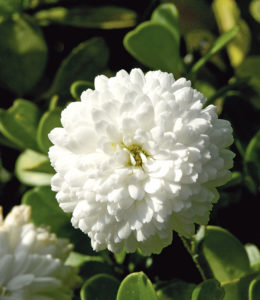
Find out more about the Roman Chamomile plant of our Aromatherapy Herbarium blog series.

ROMAN CHAMOMILE
Chamaemelum nobile
DESCRIPTION

Perennial plant measuring ten to thirty centimetres in height of the Asteraceae family, Roman or noble chamomile (Chamaemelum nobile) grows almost everywhere in Europe, with a preference for silica rich soils.
ADVICE
Essential oil of Roman chamomile is remarkably well tolerated.
DO NOT USE IN
– pregnant or breast-feeding women,
– children under the age of six years, due to the presence of ketones,
– subjects with epilepsy,
– persons allergic to one of the components (limonene),
– subjects with asthma without the advice of an allergologist before the first use.
RECIPES
Anxiety
To relieve anxiety, breath directly from a bottle of essential oil of Roman chamomile over two to three seconds.
Stress
Apply a few drops of essential oil of chamomile on the solar plexus, along the spinal column, under the arch of the foot and the internal flexion creases of the wrists.

Its stems are hairy and the whitish green leaves are finely divided in short and narrow lobes. The capitulum is formed of white ligulate florets covering each other and surrounding a yellow tubular disc flower. The fruit of chamomile is yellowish, small and ribbed.
The queen of herbal teas for old ladies and the early to bed, chamomile didn’t always have this kill-joy image. In the Egypt of the Pharaohs, it was dedicated to Ra the sun king, if glorified life, light and metamorphosis. The Greeks considered it a panacea and especially considered capable of curing malaria. They thought it smelled of ripe apple, thus its name kharaimelon “earth apple”, which became camomilla in Latin. Dioscorides and Galen recommended it for women diseases. More than twenty centuries later, it was favoured by Italians. Stendhal wrote in his “Promenades dans Rome” that they sang to their beauties: “I bless the chamomile flower”. In Central Europe, women used it to give golden highlights to their hair. In rural France, it was used for stomach pains, insomnia, migraine and eyelid inflammation.
CULTIVATION AND PRODUCTION
Roman chamomile is widely spread in temperate European regions, and in particular in France. It does not grow at high altitudes and prefers silica containing soils. These are quite common in Anjou, and it is in this region that the most sought after quality is cultivated. The Maine-et-Loire, which is the eighth French department in terms of surface dedicated to aromatic plants, has the almost exclusivity and dedicates it approximately ninety hectares.
FRAGRANCE
The flowers release a typical, pleasant and spicy odour.
EXTRACTION AND YIELD
The capitula are collected one by one, as the flowering progresses, or July to September depending on the weather and the place. The steam distillation has a very low yield of 0.4% to 1% depending on the nature of the batch. A hundred kilograms of these small flowers only give four hundred grams to a kilogram of essential oil in the best years. Often, the yield is much less!
CHEMICAL FORMULA
The active ingredients of essential oil of chamomile are mainly monoterpenols, aliphatic esters, and in particular isobutyl angelate and isoamyl angelate, and ketones whose concentration may vary depending on the composition and source of the batches.
MAIN INDICATIONS / Stress and all types of tensions do not resist the calming action of essential oil of chamomile. It gives excellent results in restless children. In adults, it soothes anxiety attacks and nervous shocks, forestalls anxiety and reconciles insomniacs with sleep. It relieves nervous origin pains, neuralgia, migraines and others. It is also very gentle for the skin (acne rosacea, sensitive skin, shaving rash), and it is recommended for pruriginous and/or allergic dermatological disorders: eczema, psoriasis, dermatitis. Finally, it is a friend of the digestive sphere and all slow digestion, flatulence and ballooning concerns. Chamomile hydrolate is used for the treatment of irritated eyes.
RELATED SPECIES
German chamomile or matricaria (Matricaria recutita).


Leave a Comment